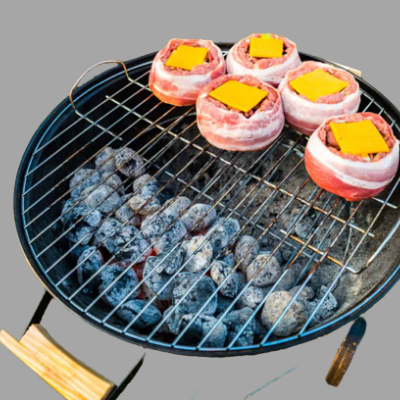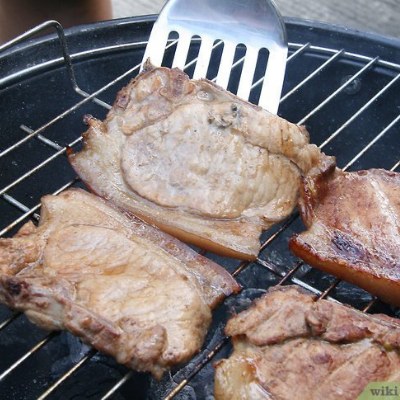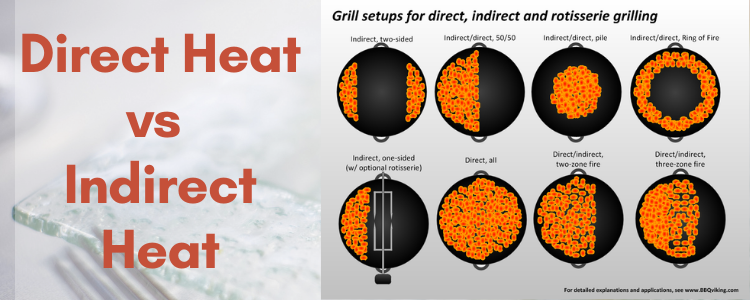The difference between a grilling beginner and a grilling expert is knowing the difference between direct and indirect heat. Over a quick flame, direct heat will produce superb grill markings, while indirect heat will get your meat to a fine temperature and make grilling desserts a breeze.
The only change is the position of the meal about the heat source. Indirect heat transport involves radiation, conduction, or convection to adjust the heat. In both indirect and direct heating, various processes are used. In this article, we will discuss direct vs indirect heating methods in detail.
What Does Direct vs Indirect Heating Mean?
In cooking, direct heating refers to applying heat directly to the food being cooked. This can be done through methods like grilling, broiling, or sautéing, where the food comes into direct contact with the heat source. Direct heating is often used when quick browning or searing is desired.
On the other hand, indirect heating in cooking involves using an intermediary medium to transfer heat to the food. This can be achieved through methods like baking or roasting, where the heat is circulated around the food in an enclosed environment. Indirect heating allows for more even and gentle cooking, ideal for dishes that require longer cooking times or for achieving a tender texture.
The choice between direct and indirect heating in cooking depends on the desired outcome and the characteristics of the food being prepared. Direct heating is suitable for quick cooking and achieving caramelization or browning, while indirect heating is preferred for slow cooking and even heat distribution.
Direct Heating Technique
The direct heating technique entails bringing a solid mass substance into straight touch with a heated gas to adjust the material’s ultimate temperature. It cooks vegetable skewers, hot dogs, and pork chops for a few minutes by using intense temperature and putting your foodstuff directly in touch with the fire.

Indirect Heating Technique
The indirect heating technique does not enable the item to contact air, gas, or another heating mediator to affect the ultimate heat. In a nutshell, grilling over direct heat is rapid and hot. Indirect heat cooking, on the other hand, is a little sluggish.

It maintains things like pork shoulders, whole chickens, and roasts from the fire, away, so they don’t burn before they finish cooking.
Direct Heat And Its Working
When most people think of grilling, they think of direct heat grilling. Foodstuff is positioned directly over the warmth foundation gas grill burners or hot charcoal and cooked for a few minutes at very high heat with the cover off.
Direct heat sears meat and veggies for a golden brown color and crisp exterior, and it’s the only way to acquire excellent grill marks. Direct heat grilling is the way to go for quick-cooking things like burgers, hot dogs, kabobs, veggies, and most seafood.
It’s also the best way to prepare thin cuts of meat like steak, boneless chicken breasts, and pork chops. It’s preferable to turn these products halfway through the cooking period so that each side has equal access to the heat.
Grilling Over Direct Heat
When grilling with direct heat, the most important thing to remember is to get your heat source right. This is simple with gas grills: Fire the flame and adjust the temperature with the built-in knobs of the grill. On the other hand, a charcoal grill or a pellet grill necessitates a little more technique.
1. Get Your Charcoal or Gas Tank Ready.
Remove the grill grates and arrange the briquette charcoal on the grill’s base or make the gas connection with the grill and light the grill.
Stacking charcoal in a pyramid is the greatest method to get it to burn quickly. You may also use a charcoal vent to orient the charcoal upright and start it on fire before adding it to your cooker.
2. Let The Grill Heat Up
Dispense a few drops of lighter liquid on top of your pyramid charcoal, then with a match, ignite it, and watch its blaze. The amount of charcoal needed depends on the amount of food you are grilling. Food grilling necessitates tolerance, which begins with allowing the coals to warm to a suitable cooking temperature. They’re usually ready to use when ash collects around the briquettes outside. In the case of a gas grill, it will heat up quickly in 20 to 30 minutes.
3. Start Preparing Your Meal.
Apply a light coating of nonstick cooking spray to your grill grate before adding the meat to be grilled. Arrange your meal on one barbecue grate in a single layer. Cooking times are usually short.

4. Control the Temperature.
The upper vent in the lid and bottom expel beneath the charcoal firebox are standard on most charcoal grills, sometimes dampers. The bottom of the grill has air vents that allow wasted charcoal to drop into a residue holder under the kettle grill and allow oxygen to feed the fire. To allow heat out, unlock the air expelled.
Most gas grills and electric grills have a temperature control system that with innate in the device but sometimes one has to purchase it additionally with the grill. set the temperature to a specific level and start grilling what you want to.
5. Keep yourself safe.
Keep in mind that lit grills are extremely hot. To flip your meat, use tongs. Ensure you don’t touch the grill’s side or even the grill cover until it is normalized. Keep an eye out for flame flare-ups, which are uncommon, but you should always be cautious while cooking outside and know what to do in flare-up conditions.
Indirect Heat And Its Working
If your food preparation will take more than 20 minutes, look for indirect heat. Inside the grill, these cooking techniques make two heat zones:
One is scorching, and the other neighboring one does not have direct admission to the warmth foundation. Because the food is not in direct contact with the fire, it can cook for longer at a lower temperature.
Why need indirect heating?
When you cook with indirect heat on a grill, you’re cooking the meal with the hot air from the BBQ. This method is ideal for foods that would otherwise burn if exposed to direct heat for an extended period of time, such as a loaf of fresh bread or roast.
How Indirect Heat Grilling Is Done?
Indirect heat grilling is done with the lid closed to keep the heat within the grill, and you can add wood chips to the mix to transform your grill into a smoker and infuse the food with more flavor. When cooking large amounts of meat, such as whole chickens, roasts, or cedar plank fish, use indirect heat grilling.
It’s also great for barbecuing when low cooking temperatures are required to tenderize tough portions of meat such as brisket, ribs, and pork shoulder. The food does not need to be rotated halfway through cooking because the heat source is never directly contacted.
Indirect Heating On Gas Grill
Half of the burners on a gas grill should be turned on. On a four-burner grill, the two outside burners can be used, or a single outside burner can be used on a three-burner barbecue.
Close the lid and let the grill heat for 10 to 15 minutes, changing the burners to higher or lower settings to control the temperature inside the grill. Place foods over the unlit burners when you’re ready to cook.
Indirect Heating On Charcoal or Pellet Grill
Using charcoal or a pellet grill, bank the hot coals or pellets to one side and the other for indirect heat cooking. You could also bank the coals or pellets to one side of the grill and place a drip pan in the center between the coals or pellets. Lump charcoal and charcoal briquettes have their own characteristic pleasant smell bestowed to the food cooking over it. Place the meat immediately over the drip pan when ready to cook.
Indirect Heating On Electric Grill
Yes, you can use an electric grill for cooking in an indirect manner; Preheat the grill to a low temperature. Cover the ceramic grates with foil. To further lessen the heat, use a grilling pan that fits your electric grill and flip it over to create a huge gap between the pan and the grill.
Grilling Techniques Using Indirect Heat
Keep in mind where you set your charcoal while cooking food using a grill over indirect heat. After placing and lighting the charcoal on the grill, you have to shift it away from the food. There are four basic methods for doing so:
1. Two-zone Technique
On one side of the grill, set your burning firewood and on the other side, put your meat in the two-zone indirect grilling area. The disadvantage is that if you leave your firewood alone, one side of the meat will cook faster than the second side. Rotate and turn over the foodstuff you’re regularly making.
2. Three-zone Technique
In this method, the meat is placed in the grill center of the grill, and dual warmth zones are created in both areas. The three-zone method allows you to slow roast your meat without turning it as much as you would do in the Two-zone technique.
3. The Method Of The Ring Of Fire
This method of grilling involves placing the meat in the grating center and surrounding it with hot coals. This procedure ensures a very even cooking.
4. The Rotisserie Process
By adding a spit to the core of the grill, this method constructs on either the ring of fire or three-zone methods. Use this spit to pierce your meat, then turn the meat to smooth assurance cooking.
The advantage of using both indirect and direct heat
Having both heat zones on your grill may be quite handy.
Using indirect and direct heat on your barbeque allows you to cook various dishes simultaneously.
| Advantages of Indirect Heating | Advantages of Direct Heating |
|---|---|
| No need for air. | It is reliable. |
| Amplified energy competence. | Environmental friendly. |
| Use less energy as compared to the direct method. |
What Is Combo Cooking and How Does It Work?
Let’s pretend you’re grilling a hefty steak or slow-cooking thick sausages like bratwurst. Indirect heat is preferable, although it does not have a pleasing golden brown tone. As a result, combine the two ways. Cook on the straight heat side first to get grill marks on both sides while flipping once. Then, transfer the meal to the roundabout side of the pan and shut the cover until it achieves the appropriate softness or temperature.
You can also employ an overturn flame method, in which you cook the item on the oblique side first and then sear it on the burning side. For those in the middle of things that are too broad to heat through on the straight side but would advantage from a caramelized outside, try combo cooking.
Pork chops or thick steaks, grilled fruit, bone-in poultry parts, and cabbage are all the finest cooked this way.
Conclusion
The main disparity between direct vs indirect heating is the transfer of the air, necessary to make easy heat diffusion. In direct heating, you cook food directly on a heat source while Indirect heat swaps do not require space, lowering energy prices and allowing for power recycling and revival systems.
Indirect heat swap schemes are an attractive, practical alternative for agricultural, mining, and powder sectors due to significant savings in energy usage and process expenses.


Pingback: How To Smoke Sausage 6 Easy Steps - Grill Pantry
Pingback: Kettle Grill Or A Barrel Grill? 8 Surprising Facts Regarding Which One Better - Grill Pantry
Pingback: 3 Types Of Grill Grates | Easy To Know The Differences - Grill Pantry
Pingback: Tricks And Tactics On How Long To Grill Chicken For Perfect Texture - Grill Pantry
Pingback: Unbaise Reviews | What Are Pellet Grills Easy To Know Features - Grill Pantry
Pingback: Easy To Understand What Are Charcoal Grills, Charcoal Types And Lightening Process - Grill Pantry
Pingback: How To Cook On A Charcoal Grill? - Grill Pantry
Pingback: How Long To Grill Corn On The Cob In Foil - Grill Pantry